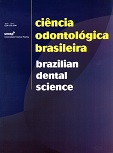Flexural strength and modulus of elasticity of four dental composites polymerized with light emitting diode (LED) and halogen light
DOI:
https://doi.org/10.14295/bds.2006.v9i3.244Abstract
The purpose of this investigation was to evaluate the flexural strength (FS) and modulus of elasticity (ME) of three microhybrid resins (Filtek Z250; Charisma; P60) and one submicrohybrid resin (Concept) using LED or halogen light polymerization. Twenty specimens (25x2x2 mm) per tested material were prepared and polymerized using a halogen or LED curing unit and stored in distilled water. FS and ME tests were performed on an Instron universal testing machine (0.75mm/min). ANOVA and multiple comparisons (SNK) showed that the two polymerization systems resulted in no significant differences (p>0.05) in the FS of Charisma and Filtek Z250. The two curing systems also produced similar results in the ME of Charisma, Concept and Filtek Z250. Significant differences were found in FS and ME, with the halogen curing light system showing better results than the LED system. The LED LCU systems did not exhibit a superior performance in our investigation of any of the composite resins, in terms of flexural strength and modulus of elasticity.
Downloads
Downloads
Published
How to Cite
Issue
Section
License
Brazilian Dental Science uses the Creative Commons (CC-BY 4.0) license, thus preserving the integrity of articles in an open access environment. The journal allows the author to retain publishing rights without restrictions.
=================




























